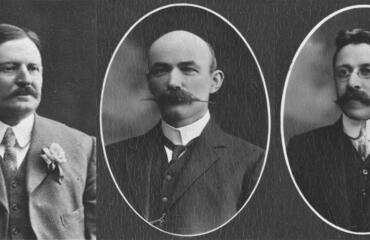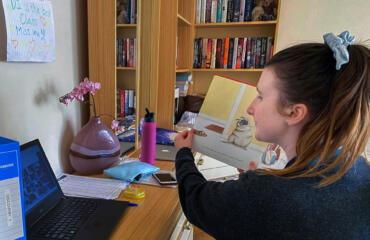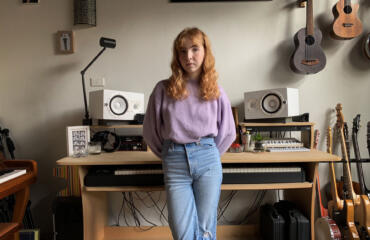It’s almost 6am when Bridget Cain plunges into the pool for her first lap of the day – the first of many for the young swimmer.
Bridget, 16, and her team of a dozen other teenagers arrive at a swimming centre in Morwell in pitch darkness and near freezing temperatures. The teens are unfazed as they dive into the pool for their first drills. They do this four days a week.
Bridget is a team captain at Traralgon Swimming Club. She has been swimming competitively since she was seven. Today is one of her last big training sessions before the Victorian State Championships on the weekend, where she will be on the blocks for her favourite event: the 400-metre individual medley.

Bridget Cain: The strong bonds within her swimming squad help her get out of bed and into the pool before dawn. “It’s just an amazing culture.” Picture: Zara Hastie
“It’s sort of exciting to see what time I can do and how everyone else goes,” she says. “A medal would be nice, but even just top five with a good [personal best time] would be great.”
It’s not just swimming that gets Bridget out of bed in the morning. The strong bonds she has with her squad help keep her motivated.
“It’s just an amazing culture,” she says. “Everyone brings each other up … they’re just like so considerate of you and I don’t think you usually get that anywhere else.”
Bridget swims laps in various strokes for the first half of practice. Towards the end of the session the swimmers takes turns trying to beat their own times while the rest of the squad cheers them on from beside the pool. When a swimmer beats their personal best time, the squad is to congratulate them with a ‘‘woop woop’’.
Developing teamwork along with swimming technique is part of coach Dean Gooch’s plan.
“The Traralgon Swimming Club’s culture is always based very strongly around being a good person first,” he says.
“Teamwork is strong and the culture is strong … You’ll find most of the athletes will continue to improve not just in the water, but in school, and in life as well.”
Mr Gooch, originally from Melbourne, says regional clubs generally have fewer members than their metropolitan counterparts, and building a strong community in the team helps retain their athletes.
One of the obstacles aspiring athletes face in rural towns is the tyranny of distance. This was recently acknowledged by the State Government, with the Sports Minister John Eren this year announcing travel grants to help regional athletes cover the costs of travel and accommodation to attend competitions.
Bridget’s home town of Yinnar does not have a swimming pool. It’s a 20-minute drive to get into the water in Morwell. The weekend after she chats with The Citizen, she will travel over two hours to Melbourne to compete.
After her hours in the pool, followed by some cardio work in the gym, Bridget begins the next phase of her day, and catches the bus to school. Hauling her swimming kit to the bus stop is like another workout in itself, she jokes.
Bridget is in year 11 at Kurnai College in Churchill, about 15 minutes drive away. Her favourite subject is math, but she also enjoys studying business and German.
She has a confident and open manner, especially when she’s talking about swimming or sport. She moves easily between social groups whether they be her squad, her school friends, or her adult teachers.
A couple of teachers joke with her as she walks across the modern quadrangle to math class. When she arrives at class, her seat at the back of the room is waiting for her – friends have saved it.
After she graduates high school next year, Bridget hopes to study primary school teaching, sports science, or physiology. “It’s really enjoyable to teach other people stuff, and share your knowledge,” she says.
Unlike many of her peers, Bridget has no plans to leave the community and head to the big smoke when she graduates. She wants to stay in Yinnar and attend the local Federation University, which has a campus in the nearby town of Churchill.
She likes being able to walk down the street and to know who her neighbours are – and having them know her and her story. Her family lives in the area and she wants to stay close to them.
She’s concerned about what might happen to the community if a lot of young people choose to move away after high school to pursue employment or higher education.
In 2006, the State Parliament conducted an inquiry into retaining young people in regional and rural areas. It found that the loss of young people can lead to a range of problems in some rural communities, not least skewing the population toward an ageing cohort, and all the economic and social issues that flow from that.
A young person’s choice to stay in Yinnar or head to a bigger town or city will always depend on the availability of employment or further study, says Geoff Block, principal at Kurnai College University Campus.
While Mr Block says a student’s future after graduation will depend on a variety of factors, he has noticed the local population “getting a bit older” in the 40 years he has lived in Yinnar.
Mr Block says some students will choose to stay because of strong family connections in the area. “It’s almost like a family by family thing, for some students they have those family connections … they have a lot of ties in the local community and they want to stay because of that.
“Other students will still have those links, but for them moving away is the only way they can really pursue their other goals.”
According to 2016 Census data, the fossil fuel electricity generation industry was the top employer of Yinnar residents. It was followed by primary education, hospitals, road freight transport and beef cattle farming.
Mr Block says the closure of Hazelwood Power Station has had a significant impact on the community, and further closures of nearby power stations would “change the valley greatly”. However, he’s hopeful new jobs could be generated by bringing new industries into the area, such as renewable energy.
“If there are other industries that can come in to provide that wider employment then I think that would help young people stay, but long term if those industries aren’t brought into the valley then I think it becomes very difficult for young people to remain.”
Bridget thinks people need to be encouraged from a young age to stay in the community. One of her worries is that younger children will lose out on having older role models if a lot of her peers leave the area after high school.
She thinks more people are leaving than in previous generations. She observes that her mother still regularly catches up with her school friends, who still live locally.
After Bridget finishes her day at school, she heads home to tutor a younger student in math. It’s a good part-time job, fitting in neatly around swimming practice.
Despite starting her day before dawn, Bridget’s busy schedule is far from over. After tutoring, she’s back on the road with her mother to another swimming pool, this one in Churchill. Along with some other members of her squad, she’ll do laps for a few more hours before she calls it a day.
It’s largely the same kids from the morning practice. They don’t go to school with Bridget, but she says this is kind of nice – having friends from different places.
The rest of the squad is gathered on the lawn outside the gym complex, warming up in the afternoon sun. The group is chatting in a circle while they slowly do their stretches.
Bridget goes out to rejoin them, the team ending the day as it started, together.

Picture: Gerard Cockburn
The story, and others in this special series A Day In The Life Of Yinnar, is co-published by ABC Gippsland. You can also click to explore the whole package of stories here.




